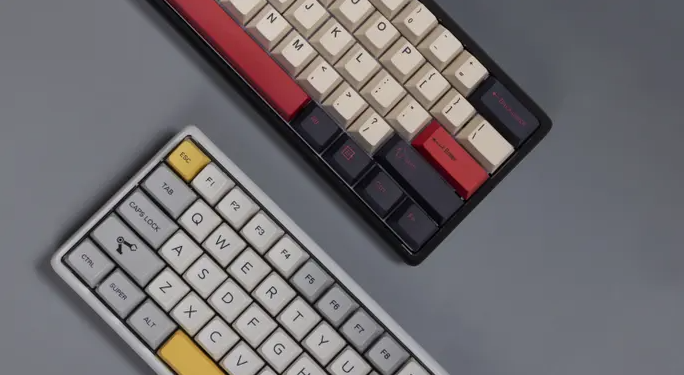It’s true that modern keyboards come in various shapes and sizes to cater to different needs and preferences. Larger keyboards typically offer more features and customization options, providing greater functionality and control. These are favored by gamers and professionals who require advanced functions. On the other hand, smaller and simpler keyboards are designed for portability and ease of use, making them more suitable for travel or casual users. If you’re new to buying a keyboard, it can indeed be overwhelming, but considering popular variants can help you make a more informed decision based on your specific requirements.

What are Full-sized keyboards?
Full-sized keyboards are computer keyboards that encompass a complete set of keys, including alphanumeric keys, function keys, navigation keys, and a numeric keypad. They typically have around 104 to 108 keys and are larger in size compared to more compact keyboard options like tenkeyless (TKL) or compact keyboards.
- -The alphanumeric section of a full-sized keyboard consists of the letters A to Z, the numbers 0 to 9, and various punctuation and symbol keys. Above the alphanumeric keys, there is a row of function keys (F1 to F12) that provide additional functionality in software applications or operating systems. Along the top edge, you’ll find specialized keys for tasks like adjusting volume, controlling media playback, accessing system functions, and launching specific applications.
- -Full-sized keyboards also feature arrow keys for navigation, a dedicated numeric keypad on the right side, and several modifier keys like Shift, Ctrl, and Alt, which are used to modify the input of other keys to perform different functions.
- -These keyboards are commonly used in desktop computer setups, gaming, professional workstations, and situations where individuals require a comprehensive set of keys with easy access to functions and numeric input.
What are Tenkeyless keyboards?
Tenkeyless keyboards, often abbreviated as TKL keyboards, are computer keyboards that eliminate the numeric keypad on the right side. They retain the alphanumeric section, function keys, and navigation keys but are more compact in size compared to full-sized keyboards.
- -A TKL keyboard typically has around 87 to 88 keys and a narrower profile, making it more portable and space-efficient.
- -While the numeric keypad is omitted, the rest of the keys found on a full-sized keyboard are still present in a tenkeyless model, including the letters A to Z, numbers 0 to 9, punctuation and symbol keys, function keys (F1 to F12), and various modifier keys like Shift, Ctrl, and Alt.
- -Tenkeyless keyboards are popular among gamers and professionals who primarily use the alphanumeric and function keys. The reduced size allows for more natural mouse positioning, which is beneficial for gaming and tasks requiring extensive mouse usage.
What are 60% keyboards?
60% of keyboards are compact computer keyboards that offer an even smaller form factor compared to tenkeyless keyboards. They are designed to be extremely space-efficient by eliminating not only the numeric keypad but also other sections like the function row, navigation keys, and sometimes even the arrow keys.
- -A 60% keyboard typically has around 61 keys, although the exact layout can vary slightly between different models. The main alphanumeric section remains intact, including the letters A to Z, numbers 0 to 9, and essential punctuation and symbol keys. However, most function keys (F1 to F12) are either removed or incorporated into a secondary layer accessed through key combinations.
- -The elimination of the arrow keys and navigation cluster can be compensated through a secondary layer as well, often accessible through a dedicated Fn (function) key.
- -Due to their highly compact size, 60% of keyboards are highly portable and popular among users who prioritize portability and minimalist aesthetics. They are favored by programmers, writers, and gamers who prefer a clean and uncluttered workspace.
There are three main types of keyboard switches:
1. Membrane switches: These switches use a rubber dome or a layer of conductive material that completes the circuit when pressed. They are commonly found in budget keyboards due to their low cost and quiet operation.
2. Mechanical switches: These switches use individual mechanical components for each key, resulting in a more tactile and responsive typing experience. There are several types of mechanical switches, including:
- – Clicky switches: These switches have an audible click sound and a tactile bump when pressed, providing both auditory and tactile feedback. Examples include Cherry MX Blue and Kailh Box White.
- – Tactile switches: These switches have a tactile bump when pressed but do not produce an audible click. They provide tactile feedback without the accompanying sound. Examples include Cherry MX Brown and Kailh Box Brown.
- – Linear switches: These switches provide a smooth keystroke without a tactile bump or audible click. They are known for their linear movement and are often preferred by gamers. Examples include Cherry MX Red and Kailh Box Red.
3. Optical switches: These switches use an infrared light beam to detect key presses. They offer faster actuation and can be more durable compared to mechanical switches. Optical switches come in various configurations, including clicky, tactile, and linear options.